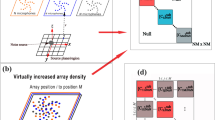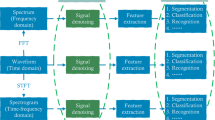Abstract
Blind source separation (BSS) has an extensive application prospect in many fields, and independent component analysis (ICA) is a very effective tool for solving the BSS problem. Noisy BSS/ICA, as it approaches the reality, is frequently considered in many practical applications. In this paper, we mainly discuss the “sensor” noise, adding Gaussian white noise to the music audio mixtures. To solve noisy BSS/ICA problem, we deploy denoising pre-processing before performing FastICA. Rather than traditional wavelet shrinkage, we employ a more advanced shrinkage denoising algorithm, parallel coordinate descent (PCD) iterative shrinkage based on redundant dictionary, to accomplish the denoising task. Since the classical nonlinearities (tanh and gauss) used in FastICA are not the optimal ones due to their slow computational speed, we propose two novel rational nonlinearities that have faster computational speed and almost the same or better separation performance comparing with the classical ones. As they originate from Pade approximant of tanh and gauss, but the coefficients are adjusted, we name them Variant Tanh Pade (VTP) and Variant Gauss Pade (VGP), respectively.















Similar content being viewed by others
Notes
All the signals downloaded from: http://www.freesound.org/. type: wav; sample rate: 44,100; bit depth: 16; bit rate: 1,411; channels:2.
References
A. Adler, V. Emiya, M.G. Jafari, M. Elad, R. Gribonval, M.D. Plumbley, Audio inpainting. IEEE Trans. Audio Speech Lang. Process 20(3), 922–932 (2012)
T.Z. Boulmezaoud, M. El Rhabi, H. Fenniri, E. Moreau, On convolutive blind source separation in a noisy context and a total variation regularization. IEEE Eleventh International Workshop on signal processing advances in wireless communications (SPAWC), pp. 1–5 (2010)
M. Brookes, Voicebox. Department of Electrical & Electronic Engineering, Imperial College, London, UK, http://www.ee.ic.ac.uk/hp/staff/dmb/voicebox/voicebox.html
N.P. Castellanos, V.A. Makarov, Recovering EEG brain signals: artifact suppression with wavelet enhanced independent component analysis. J. Neurosci. Methods 158, 300–312 (2006)
F. Cong, X. Xu, S. Zhou, S. Du, X. Shi, Particle filtering based noisy blind source separation. Electroni. Lett. 43(9), 547–549 (2007)
D.L. Donoho, I.M. Johnstone, Ideal spatial adaptation by wavelet shrinkage. Oxf. J. Life Sci. Math. Phys. Sci. Biom. 81(3), 425–455 (1993)
M. Elad, Why simple shrinkage is still relevant for redundant representations? IEEE Trans. Inf. Theory 52(12), 5559–5569 (2006)
M. Elad, B. Matalon, J. Shtok, M. Zibulevsky, A wide-angle view at iterated shrinkage algorithms. Proc. SPIE, Wavelets XII, vol. 6701, article id. 670102 (2007).
M. Elad, B. Matalon, M. Zibulevsky, Coordinate and subspace optimization methods for linear least squares with non-quadratic regularization. Appl. Comput. Harmon. Anal. 23(3), 346–367 (2007)
M. Elad, M.A.T. Figueiredo, Y. Ma, On the role of sparse and redundant representations in image processing. Proc. IEEE 98(6), 972–982 (2010)
H.Y. Gao, Wavelet shrinkage denoising using the non-negative garrote. J. Comput. Graph. Stat. 7(4), 469–488 (1998)
A. Hyvarinen, Fast and robust fixed-point algorithms for independent component analysis. IEEE Trans. Neural Netw. 10(3), 626–634 (1999)
A. Hyvarinen, FastICA for noisy data using gaussian moments. Proceedings of the 1999 IEEE international symposium on circuits and systems, 1999 (ISCAS ’99), vol. 5 (1999), pp. 57–61.
A. Hyvarinen, J. Karhunen, E. Oja, Independent Component Analysis (Wiley, New York, 2001)
Z. Koldovský, P. Tichavský, Blind instantaneous noisy mixture separation with best interference-plus-noise rejection, ed. by M.E. Davies et al. (ICA 2007, LNCS 4666), pp. 730–737 (2007).
Z. Koldovský, P. Tichavský, Asymptotic analysis of bias of FastICA-based algorithms in presence of additive noise. Institute of Information Theory and Automation, Czech Republic, Technical report no 2181 (2007), http://itakura.kes.tul.cz/zbynek/publications.htm
Z. Koldovský, P. Tichavský, E. Oja, Efficient variant of algorithm FastICA for independent component analysis attaining the Cramér-Rao lower bound. IEEE Trans. Neural Netw. 17(5), 1265–1277 (2006)
X.L. Li, T. Adali, Independent component analysis by entropy bound minimization. IEEE Trans. Signal Process. 58(10), 5151–5164 (2010)
X. Liu, X.Z. Tan, S.M. Wei, A.A. Anghuwo, Blind source separation algorithm based on wavelet denoising. First international conference on pervasive computing signal processing and pervasive computing signal processing and applications (PCSPA), pp. 739–742 (2010).
S. Mallat, A Wavelet Tour of Signal Processing—The Sparse Way, 3rd edn. (Academic, New York, 2009), pp. 611–695
A. Paraschiv-Ionescu, C. Jutten, K. Aminian, B. Najafi, Ph. Robert, Source separation in strong noisy mixtures: a study of wavelet denoising pre-processing. IEEE international conference on acoustics, speech, and signal processing (ICASSP), vol. 2, pp. 1681–1684 (2002).
W.H. Press, S.A. Teukolsky, W.T. Vetterling, B.P. Flannery, Numerical Recipes—The Art of Scientific Computing, 3rd edn. (Cambridge University Press, New York, 2007), pp. 245–246
B. Rivet, V. Vigneron, A. Paraschiv-Ionescu, C. Jutten, Wavelet denoising for blind source separation in noisy mixtures. Fifth international conference on independent component analysis and blind signal separation: ICA, Granada. Spain 2004, pp. 263–270 (2004).
R. Romo-Vázquez, H. Vélez-Pérez, R. Ranta, V. Louis Dorr, D. Maquin, L. Maillard, Blind source separation, wavelet denoising and discriminant analysis for EEG artefacts and noise cancelling. Biomed. Signal Process. Control 7(4), 389–400 (2012)
H. Shen, M. Kleinsteuber, K. Huper, Local convergence analysis of FastICA and related algorithms. IEEE Trans. Neural Netw. 19(6), 1022–1032 (2008)
C. Taswell, The what, how, and why of wavelet shrinkage denoising. Comput. Sci. Eng. 2(3), 12–19 (2000)
P. Tichavský, Z. Koldovský, E. Oja, Performance analysis of the FastICA algorithm and Cramér-Rao bounds for linear independent component analysis. IEEE Trans. Signal Process. 54(4), 1189–1203 (2006)
P. Tichavský, Z. Koldovský, E. Oja, Speed and accuracy enhancement of linear ICA techniques using rational nonlinear functions, ed. by M.E. Davies et al. (ICA 2007, LNCS 4666), pp. 285–292 (2007).
M. Zibulevsky, M. Elad, L1–L2 optimization in signal and image processing. IEEE Signal Process. Mag. 27(3), 76–88 (2010)
Author information
Authors and Affiliations
Corresponding author
Appendix
Appendix
Rights and permissions
About this article
Cite this article
He, Xs., Zhu, T. ICA of Noisy Music Audio Mixtures Based on Iterative Shrinkage Denoising and FastICA Using Rational Nonlinearities. Circuits Syst Signal Process 33, 1917–1956 (2014). https://doi.org/10.1007/s00034-013-9731-z
Received:
Revised:
Published:
Issue Date:
DOI: https://doi.org/10.1007/s00034-013-9731-z




